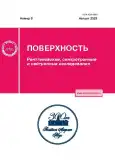Fracture-Resistant Zirconia-Based Composite Ceramics with Increased Surface Layer Hardness
- Autores: Dmitrievskiy A.A.1, Zhigacheva D.G.1, Efremova N.Y.1, Vasyukov V.M.1, Grigoriev G.V.1
-
Afiliações:
- Derzhavin Tambov State University
- Edição: Nº 8 (2023)
- Páginas: 107-112
- Seção: Articles
- URL: https://journals.rcsi.science/1028-0960/article/view/137804
- DOI: https://doi.org/10.31857/S1028096023080071
- EDN: https://elibrary.ru/OAKWKU
- ID: 137804
Citar
Texto integral
Resumo
A two-layer alumina toughened zirconia composite ceramic stabilized with calcium oxide (Ca-ATZ) was produced using a relatively economical powder metallurgy method. One of the layers contains silica additive (Ca-ATZ + SiO2). The structure, elemental and phase composition as well as the complex of mechanical properties nearby of the Ca-ATZ/Ca-ATZ + SiO2 interface has been investigated. It was shown that the presence of a sharp interface of layers with different elemental composition did not cause structural disorders (appearance of pores, cracks and other macroscopic defects that contribute to the deterioration of strength properties) or changes in the phase composition (more than 90% of zirconia in both layers was in the tetragonal phase, which provided a high role of the transformation toughening mechanism). Demonstrated preservation of structural integrity and ratio of monoclinic, tetragonal and cubic zirconia phases at formation of sharp interface of the mentioned layers, provides possibility of manufacturing of zirconia-based ceramics with thin (100–200 μm) modified layer. Taking into account the difference in mechanical properties of Ca-ATZ and Ca-ATZ + SiO2 ceramics, this provides the basic material (containing SiO2) increased fracture toughness (not less than 12 MPa m1/2), and near surface layer (not containing SiO2) high hardness (not less than 14 GPa).
Sobre autores
A. Dmitrievskiy
Derzhavin Tambov State University
Autor responsável pela correspondência
Email: aadmitr@yandex.ru
392000 Russia, Tambov
D. Zhigacheva
Derzhavin Tambov State University
Email: aadmitr@yandex.ru
392000 Russia, Tambov
N. Efremova
Derzhavin Tambov State University
Email: aadmitr@yandex.ru
392000 Russia, Tambov
V. Vasyukov
Derzhavin Tambov State University
Email: aadmitr@yandex.ru
392000 Russia, Tambov
G. Grigoriev
Derzhavin Tambov State University
Email: aadmitr@yandex.ru
392000 Russia, Tambov
Bibliografia
- Surface Modification of Biomaterials. Methods Analysis and Applications / Ed. Williams R. Woodhead Publishing, 2011.
- Surface Modification by Solid State Processing / Ed. Miranda R. Woodhead Publishing, 2014.
- Jain I.P., Agarwal G. // Surf. Sci. Rep. 2011. V. 66. P. 77. https://doi.org/10.1016/j.surfrep.2010.11.001
- Egerton R.F // Micron. 2019. V. 119. P. 72. https://doi.org/10.1016/j.micron.2019.01.005
- Ushakov I.V. // Proc. SPIE. Nanodesign Technol. Computer Simulations. 2007. V. 6597. P. 659714. https://doi.org/10.1117/12.726773
- Ushakov I.V., Feodorov V.A., Permyakova I.J. // Proc. SPIE. Int. Soc. Optical Engineer. 2004. V. 5400. P. 265. https://doi.org/10.1117/12.555529
- Tao F., Liu Y., Ren X., Wang J., Zhou Y., Miao Y., Ren F., Wei Sh., Ma J. // J. Energy Chem. 2022. V. 66. P. 397. https://doi.org/10.1016/j.jechem.2021.08.022
- Alagatu A., Dhapade D., Gajbhiye M., Panjrekar R., Raut A. // Mater. Today: Proc. 2022. V. 60. P. 2245. https://doi.org/10.1016/j.matpr.2022.03.338
- Koizumi M. // Ceram. Eng. Sci. Proc. 1992. V. 13. P. 333. https://doi.org/10.1002/9780470313954.ch33
- Miyamoto Y., Kaisser W., Rabin B.H., Kawasaki A., Ford R.G. Functionally Graded Materials: Design, Processing, and Applications. New York: Springer Science & Business Media, 1999.
- Pasha A., Rajaprakash B.M. // Mater. Today: Proc. 2022. V. 52. P. 379. https://doi.org/10.1016/j.matpr.2021.09.066
- Sun J., Ye D., Zou J., Chen X., Wang Y., Yuan J., Liang H., Qu H., Binner J., Bai J. // J. Mater. Sci. Technol. 2023. V. 138. P. 1. https://doi.org/10.1016/j.jmst.2022.06.039
- Sam M., Jojith R., Radhika N. // J. Manuf. Process. 2021. V. 68. P. 1339. https://doi.org/10.1016/j.jmapro.2021.06.062
- Besisa D.H.A., Ewais E.M.M. // Mater. Res. Express. 2019. V. 6. P. 075516. https://doi.org/10.1088/2053-1591/ab177e
- Ewais E.M.M., Besisa D.H.A., Zaki Z.I., Kandil A.E.H.T. // J. Eur. Ceram. Soc. 2012. V. 32. P. 1561. https://doi.org/10.1016/j.jeurceramsoc.2012.01.016
- Dmitrievskii A.A., Zhigachev A.O., Zhigacheva D.G., Rodaev V.V. // Tech. Phys. 2020. V. 65. № 12. P. 2016. https://doi.org/10.1134/S1063784220120075
- Dmitrievskiy A.A., Zhigacheva D.G., Vasyukov V.M., Ovchinnikov P.N. // J. Phys. Conf. Ser. 2021. V. 2103. P. 012075. https://doi.org/10.1088/1742-6596/2103/1/012075
- Dmitrievskiy A.A., Zhigacheva D.G., Grigoriev G.V., Ovchinnikov P.N. // J. Surf. Invest. X-Ray. Synchrotron and Neutron Techn. 2021. V. 15. V. 1. P. S137. https://doi.org/10.1134/S1027451022020264
- Anstis G.R., Chantikul P., Lawn B.R., Marshall D.B. // J. Am. Ceram. Soc. 1981. V. 64. № 9. P. 533. https://doi.org/10.1111/j.1151-2916.1981.tb10320.x
- Zhang F., Lin L.F., Wang E.Z. // Ceram. Int. 2015. V. 41. P. 2417. https://doi.org/10.1016/j.ceramint.2015.06.081
- Garvie R.C., Hannink R.H.J., Pascoe R.T. // Nature. 1975. V. 258. P. 703. https://doi.org/10.1038/258703a0
- Hannink R.H.J., Kelly P.M., Muddle B.C. // J. Am. Ceram. Soc. 2000. V. 83. № 3. P. 461.https://doi.org/10.1111/j.1151-2916.2000.tb01221.x
Arquivos suplementares











